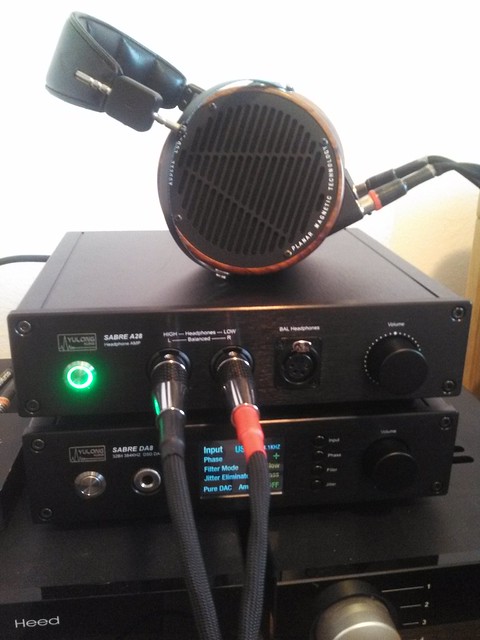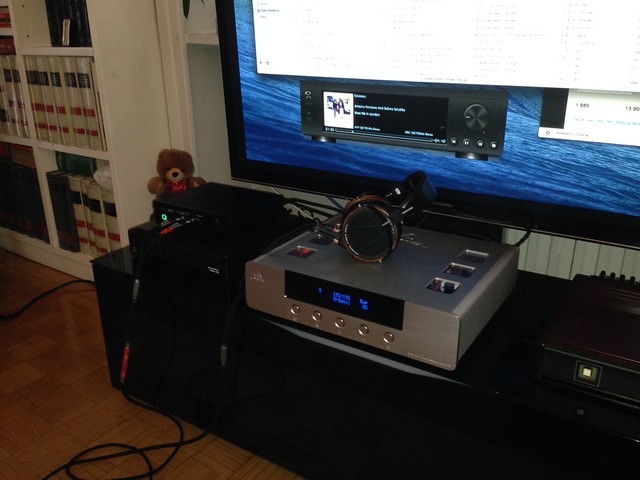This time, under exam is the Yulong A28, an affordably priced full balanced amplifier. The amp has both balanced and single ended inputs / outputs, but it is mainly thought to work in balanced mode, meaning a few things: it expects the signal to be natively balances (XLR inputs); it doesn’t employ expensive transformers for doing balanced to single ended conversion (to keep the cost lower), because it aims to be used mainly as a balanced amplifier.
The A28 is the same foot print as the Yulong DA8 (the two can be stacked), and has two 3-pins XLR outs (for left and right balanced channels), a four pin XLR out (single balanced connector for both channels), and two different single ended headphone outs, one thoughts for very low impedance headphones (like in-ear monitors), the other for full size headphones.
Test System
Sources: Yulong DA8, AMR DP-777
Headphones: Audeze LCD2 Rev2, AKG K1000, Sennheiser HD598
Amplifiers: Yulong A28, AMB/Cavalli CKKIII

Sound Quality
The signature of the Yulong A28 consists of a very powerful, dynamic sound, with more bass extension than the CKKIII amplifier, and slightly better plane separation. My main headphone for the test has been Aude’ze LCD2 Rev2, with both balanced and single ended connector. The two DAC’s used for this test, the Yulong DA8 and the AMR DP777 have both balanced and single ended outs. I have tried to do side-by-side comparisons in order to minimize the differences in balanced vs single ended output quality inherent to each DAC.
Listening to the LCD2 on the A28 (balanced) and the CKKIII (single ended), the sound is slightly lighter with the CKKIII, while there is a stronger sense of immersion with the A18, given by the deeper bass output, which can be described as being enveloped in sphere of music, where all the “soundscapes” are presented very clearly.
This feeling, which is a design goal of the LCD-2, is less noticeable with the CKKIII, which instead offers presents the LCD2 with a leaner bass output, focusing the sound more on vocals clarity.
Testing the A28 single ended mode with the LCD-2 (single ended input from both DAC’s), the A28 sounds slightly closer to the CKKIII tonality, and the LCD2 gets more midcentric while losing some bass strength. The balanced Yulong offers more layer separation and better bass control than its single ended counterpart.
Testing single ended mode with the Sennheiser HD598, and comparing it on both the CKKIII and the A28, the CKKIII offers slightly more open vocals, while bass output and detail rendition are on the same level.
I also used an AKG K1000, which I have been lent by a friend, mainly for fun since they require a speaker amp to sound properly. This is a later model (apparently a bass-light model), and right now, with all kind of sources and amplification, I can’t stop thinking this specific pair of K1000 sounds plasticky and unrealistic, and it also does here, with both the Yulong and CKKIII… hence I cannot say much out of this test, apart from the obvious note that the A28 is capable of drives them to volume.

Conclusion
The Yulong A28 is a fully balanced amplifier and offers a neutral presentation. The lower range of the spectrum is powerful and more energic than the CKKIII, which is very desirable especially with a headphone which will take advantage of it, like the LCD2.
Neither amplifier has any problem in resolution and amount of detail retrieval, which was a problem, for example, with Burson HA160DS amplifier I tried in the past, and I found to be a bit too bloomy in the bass.
People who own a DAC with balanced option, and headphones that work dinstinctively better in balanced mode than single ended (like said Audeze LCD2, Sennheiser HD600 or 6HD50), should consider the A28 in the 500-600$ bracket, where most competitors are single ended.


